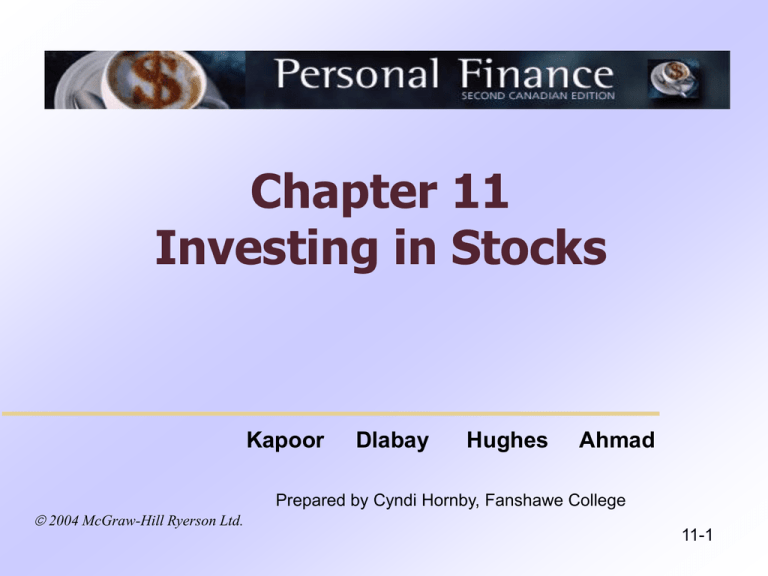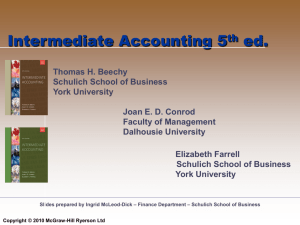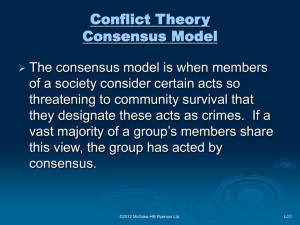Investing in Stocks Chapter Sixteen
advertisement

Chapter 11 Investing in Stocks Kapoor 2004 McGraw-Hill Ryerson Ltd. Dlabay Hughes Ahmad Prepared by Cyndi Hornby, Fanshawe College 11-1 Learning Objectives – Chapter 11 1. Identify the most important features of a common stock. 2. Discuss the most important features of preferred stock. 3. Explain how you can evaluate stock investments. 4. Describe how stocks are bought and sold. 5. Explain the trading techniques used by longterm investors and short-term speculators. 11-2 2004 McGraw-Hill Ryerson Ltd. Learning Objective # 1 Identify the most important features of a common stock. 11-3 2004 McGraw-Hill Ryerson Ltd. How Are The Markets Doing? Index: a statistical measure of the changes in a portfolio of stocks representing a portion of the overall market. S&P/TSX Composite Index Dow Jones Industrial Average NYSE Composite Index Nasdaq Composite Index Standard & Poor’s 500 Stock Index 11-4 2004 McGraw-Hill Ryerson Ltd. Investing in Stocks Why do corporations issue common stock? To raise money to start or expand a business. To help pay for ongoing business expenses. They don’t have to repay the money. Dividends are not mandatory. Stockholders have voting rights. 11-5 2004 McGraw-Hill Ryerson Ltd. Why Do Investors Purchase Stock? Income from dividends. Dollar appreciation of stock value. Possible increased value from stock splits (a procedure in which the shares of common stocks owned by existing shareholders are divided into a larger number of shares. 2004 McGraw-Hill Ryerson Ltd. 11-6 Learning Objective # 2 Discuss the most important features of preferred stocks. 11-7 2004 McGraw-Hill Ryerson Ltd. Preferred Stock Receive cash dividends before common stock holders are paid any cash dividends. The dividend amount is either a stated amount of money for each share of preferred stock, or a percentage of the par value. Par value is an assigned dollar value that is printed on a stock certificate. Callable preferred stock is stock a corporation may exchange for a specified amount of money. After calling an issue, they can issue new preferred stock with a lower dividend. First claim on corporation’s assets. 2004 McGraw-Hill Ryerson Ltd. 11-8 Features of Preferred Stock Cumulative feature. Unpaid cash dividends accumulate and must be paid before any cash dividends are paid to the common stock holders. Participation feature. Rare form of investment used to attract investors. Can share in earnings beyond the stated dividend amount. Conversion feature. Can be traded for shares of common stock. 11-9 2004 McGraw-Hill Ryerson Ltd. Learning Objective # 3 Explain how you can evaluate stock investments. 11-10 2004 McGraw-Hill Ryerson Ltd. Classification of Stock Investments Blue chip stock. Safe investment in strong and respected companies. Attracts conservative investors. ex. Bell Canada, Royal Bank Income stock. Pays higher than average dividends. ex. utility stock. 11-11 2004 McGraw-Hill Ryerson Ltd. Classification of Stock Investments (continued) Growth stock. Earns above average profits of all firms in the economy. Less than 30% of earnings are paid out as dividends, with rest reinvested in research & development ex. Southwest Airlines, Home Depot 11-12 2004 McGraw-Hill Ryerson Ltd. Classification of Stock Investments (continued) Cyclical stock. Follows the business cycle of advances and declines in the economy. ex. automobiles, timber, and steel. Defensive stock. Remains stable during declines in the economy. ex. Kellogg, Procter & Gamble and utility stocks. 11-13 2004 McGraw-Hill Ryerson Ltd. Classification of Stock Investments (continued) Large cap stocks. Issued by a large corporation that has a large amount of stock outstanding & a large amount of capitalization. Capitalization. The total amount of securities--stocks and bonds-issued by a corporation. Small cap stocks. Issued by a company that has a capitalization of $150 million or less. Penny Stocks. Typically sell for less than $1 per share. 11-14 2004 McGraw-Hill Ryerson Ltd. Sources of Information on Stocks Newspapers The Internet Stock Advisory Services Charge a fee Hundreds to choose from Corporate News Disclose information about corporate earnings, assets and liabilities, products or services 11-15 2004 McGraw-Hill Ryerson Ltd. Factors that influence the price of Stocks Bull market. Investors are optimistic about nation’s economy. More investors are buying stock and the stock market increases. Bear market. Investors are pessimistic about economy. More investors are selling stock so and the stock market declines. 11-16 2004 McGraw-Hill Ryerson Ltd. Numeric Measures to Consider When Evaluating a Stock Book Value Determined by deducting all liabilities from the corporations assets and dividing the remainder by the number of outstanding shares of common stock. May be little correlation with market value. Book Value = Assets – Liabilities Outstanding Shares 11-17 2004 McGraw-Hill Ryerson Ltd. Numeric Measures to Consider When Evaluating a Stock Current Yield Yearly dollar count of income generated by an investment divided by the investment’s current market value Current Yield = Annual Income Amount Outstanding Shares 11-18 2004 McGraw-Hill Ryerson Ltd. Numeric Measures to Consider When Evaluating a Stock Total shareholder Return (TSR) Includes the yearly dollar amount of income plus any increase or decreased in the original purchase price of the investment TSR = Current Return + Capital Gain 11-19 2004 McGraw-Hill Ryerson Ltd. Numeric Measures to Consider When Evaluating a Stock Annualized Holding Period Yield Calculation that takes into account total return, original investment and time investment is held Annualized Holding Period Yield = TSR x 1 Original N umber of Investment Years Investment Held 11-20 2004 McGraw-Hill Ryerson Ltd. Numeric Measures to Consider When Evaluating a Stock Earnings per share are the corporation’s after-tax earnings divided by the number of outstanding shares of common stock. Price-earnings (PE) ratio. Price of one share of stock divided by the earnings per share of stock over the last 12 months. A low price-earnings ratio means a stock could be a good investment. Beta An index that compares risk of a specific stock with risk of the market in general 11-21 2004 McGraw-Hill Ryerson Ltd. Investment Theories Fundamental theory Based on the assumption that a stock’s intrinsic or real value is determined by the company’s future earnings. Fundamentalists consider the… • Financial strength of the company. • Type of industry company is in. • New-product development. • Economic growth of the overall economy. 11-22 2004 McGraw-Hill Ryerson Ltd. Investment Theories Technical theory Based on the assumption that a stock’s value is determined by the forces of supply and demand in the stock market as a whole. Not based on expected earnings or the intrinsic value of a stock but rather on factors found in the market as a whole. Chartists plot past price movements and other market averages to observe trends they used to predict a stock’s future value. 11-23 2004 McGraw-Hill Ryerson Ltd. Investment Theories Efficient market theory Sometimes called the random walk theory. Based on the assumption that stock price movements are purely random. A stock’s current market price reflects its true value. It is impossible for an investor to outperform the average for the stock market as a whole over a period of time. 11-24 2004 McGraw-Hill Ryerson Ltd. Learning Objective # 4 Describe how stocks are bought and sold. 11-25 2004 McGraw-Hill Ryerson Ltd. Primary Market for Stocks A market in which an investor purchases financial securities via an investment bank, or other representative, from the issuer of those securities. An investment bank is a financial firm that assists corporations in raising funds usually by helping to sell new security issues. An IPO occurs when a corporation sells stock to the general public for the first time. 11-26 2004 McGraw-Hill Ryerson Ltd. Secondary Market for Stocks A market for existing financial securities that are currently traded among investors. A marketplace where member brokers who represent investors meet to buy and sell securities. The securities sold at an exchange must be listed, or accepted for trading, at the exchange. Toronto Stock Exchange or Canadian Venture Exchange The Over-the-Counter (OTC) market. Network of dealers who buy and sell the stocks of companies not listed on a securities exchange; NASDAQ (an electronic marketplace) 11-27 2004 McGraw-Hill Ryerson Ltd. Brokerage Firms and Account Executives An account executive, or stockbroker, is a licensed individual who buys and sells securities for his or her clients. Churning. Excessive buying and selling of securities to generate commissions. Discount broker versus full service brokers. Cost of research material Help in making decisions Ease of buying and selling 11-28 2004 McGraw-Hill Ryerson Ltd. Stock Transactions A market order is a request to buy or sell stock at the current market value. A limit order is a request to buy or sell a stock at a specified price or price range. A stop order is a request to sell a stock at the next available opportunity after its market price reaches a specified amount. A discretionary order lets the account executive decide when to execute the transaction and at what price. 11-29 2004 McGraw-Hill Ryerson Ltd. Stock Transactions (continued) Computerized transactions. Discount brokerage firms and some full services brokerage firms allow investors to trade online. It can make the process cheaper and faster. Commission charges. Wide range depending on the amount of service. Round lot is 100 shares or multiples of 100 shares. An odd lot is fewer than 100 shares. 11-30 2004 McGraw-Hill Ryerson Ltd. Securities Regulation To ensure full, true and plain disclosure of all facts by sellers of securities Provincial Regulation Registration Disclosure Enforcement Self Regulatory Organizations Are responsible for industry conformity with securities legislation 11-31 2004 McGraw-Hill Ryerson Ltd. Learning Objective # 5 Explain the trading techniques used by long-term investors and short-term speculators. 11-32 2004 McGraw-Hill Ryerson Ltd. Long-Term and Short-Term Investment Strategies Long-term techniques. Buy and hold technique. Dollar cost averaging. Direct investment and dividend reinvestment. Short-term techniques. Buying stock on margin (borrowing money). Selling short (borrowing stock). Trading in options. 2004 McGraw-Hill Ryerson Ltd. 11-33



